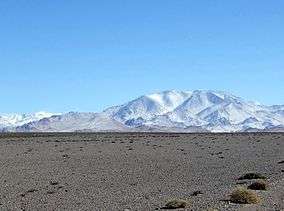San Guillermo National Park
| San Guillermo National Park | |
|---|---|
| Parque Nacional San Guillermo | |
|
IUCN category II (national park) | |
 | |
| Location | Iglesia Department, San Juan Province, Argentina |
| Coordinates | 29°25′00″S 69°15′00″W / 29.4167°S 69.25°WCoordinates: 29°25′00″S 69°15′00″W / 29.4167°S 69.25°W |
| Area | 160.000 hectares |
| Established | 1998 |
San Guillermo National Park (Spanish: Parque Nacional San Guillermo) is a national park in Argentina, in the Iglesia Department of San Juan Province. It was established in 1999 and is part of the San Guillermo Biosphere Reserve. The highest point of the biosphere reserve is about 6,000 m (19,700 ft). It consists of grasslands, wetlands, and canyons. The animals there include vicuña, guanaco, culpeo fox, Andean mountain cat, cougar, and Andean condor.[1]
The park
The San Guillermo National Park is located in the northern part of San Juan Province, Argentina near the town of Rodeo and was established on January 13, 1999. It has an area of 166,000 hectares in the High Andes, and includes puna grassland and mountain summits.[2] It was originally set up as a provincial reserve in 1972 and became the San Guillermo Biosphere Reserve in 1980. Its main objective is to preserve the natural habitat of vicuñas, and at the same time protect the other plants and animals of this mountain area.[3] [4]
Ecology
The altitude of the biosphere reserve varies between 1,000 and 6,000 m (3,300 and 19,700 ft). It totals 981,000 hectares (2,420,000 acres) with a core area of 42,000 hectares (100,000 acres) and consists of arid mountain ranges with no permanent water courses. The soils are mostly coarse, but in some parts, mostly above 3,500 m (11,483 ft), better soils support steppe grassland. The flora consists of scattered dwarf shrubs, interspersed with coarse grasses and herbaceous plants, and much bare ground. The shrubs include Adesmia, Patrastrephia, Fabiana, Azorella and Ephedra. Grasses present include Stipa, Calamagrostis and Festuca and flowering plants include Astragalus, Tropaeolum, Phacelia and Glandularia.[4]
The main reason for setting up the biosphere reserve was to protect vicuñas. Also present in the reserve are the guanaco, the culpeo fox, the Andean mountain cat, the cougar, the southern viscacha, the short-tailed chinchilla, the Darwin's rhea, various ducks and geese, and the Andean condor.[4]
Research
A research project involves fitting cougars, the top predator in the park, with GPS radio collars and tracking their movements. Simultaneously vicuñas, one of their main prey animals, are being fitted with collars to monitor their behaviour. It has been found that in areas of the park with plenty of cover, such as canyons and wetlands, the vicuñas are much more alert to danger and consequently spend less time feeding than they do on open plains. This alters the composition of the plant species present with a resulting increase in invertebrates and in biodiversity. There are plans to fit some condors with collars to find out to what extent they benefit from an increase in the frequency of vicuña kills.[1]
References
- 1 2 Lee, Jane J. (December 2014). "Andean Pumas Bring National Park in Argentina Back to Life". National Geographic. Retrieved 10 February 2016.
- ↑ "Parque Nacional San Guillermo" (in Spanish). Administración de Parques Nacionales, Argentina. Retrieved 10 February 2016.
- ↑ "Reserva de Biósfera San Guillermo" (in Spanish). reservasanguillermo.com. Retrieved 10 February 2016.
- 1 2 3 IUCN Directory of Neotropical Protected Areas. IUCN. 1982. pp. 28–29. ISBN 978-0-907567-62-2.